Lithology, Monsoon and Sea-Surface Current Control on Provenance, Dispersal and Deposition of Sediments over the Andaman Continental Shelf
- 1Physical Research Laboratory, Ahmedabad, India
- 2National Institute of Oceanography, Goa, India
Sediments deposited on the Northern and Eastern Andaman Shelf along with a few sediments from the Irrawaddy and the Salween Rivers are studied for their elemental, Sr and Nd concentrations and their isotope composition to identify their sources, constrain their transport pathways and to assess the factors influencing the erosion in the catchment and their dispersal and deposition over the Andaman Shelf region. Major elemental compositions of the shelf sediments suggest mafic lithology such as ophiolites, ultrabasic rocks, and andesites in the Irrawaddy drainage and over Indo–Burman–Arakan (IBA) ranges as their dominant source. 87Sr/86Sr ratios in sediments of the Northern and Eastern Andaman Shelf range between 0.712245 and 0.742183 whereas, εNd varie from −6.29 to −17.25. Sediments around Mergui have the highest 87Sr/86Sr and the lowest εNd values. Sr and Nd isotope compositions of these sediments along with that in the potential sources suggest four major sources of these sediments to the Andaman Shelf, (i) the Irrawaddy River, (ii) the Salween River, (iii) Rivers draining the IBA ranges and (vi) Rivers draining the Western/Central granitic ranges of the Southern Myanmar and Western Thailand such as the Tavoy and the Tanintharyi Rivers. Erosion in the catchment is controlled by the precipitation and topography. Intensely focused precipitation over the higher relief of the western slopes of the IBA and Western/Central granitic ranges causes higher erosion over this mountainous region, supplying huge sediments through the Kaladan, Irrawaddy, Salween, and the Tanintharyi Rivers to the Western Myanmar Shelf, Northern, and Eastern Andaman Shelves respectively. The majority of the sediments produced in the drainage are delivered to the shelf during the south–west monsoon which is dispersed eastward by sea-surface circulation from the mouth of the Irrawaddy Rivers toward the Gulf of Martaban and further southward. The Andaman Shelf receives very little sediment, if any, from the Ganga–Brahmaputra Delta. Higher erosion over the Western/Central granitic belt of the Southern Myanmar and Western Thailand and its importance in delivering sediments through the rivers draining its western slope such as the Tanintharyi and the Tavoy Rivers to the Eastern Andaman Shelf around the Mergui Archipelago are highlighted for the first time in this study.
Introduction
Rivers are the primary transporters of physically and/or chemically weathered continental materials to the ocean. They play a prominent role in the evolution of coastal and deep sea sediments. Terrigenous sediments eroded from the Himalayas, Myanmar, and Indo–Burman subcontinents are deposited to the Andaman Sea by rivers such as the Irrawaddy (Ayeyarwaddy), the Salween (Thanlwin), the Sittang, the Kaladan and the Tanintharyi etc. The Irrawaddy is the third largest river in the world in terms of suspended sediment discharge and together with the Salween contributes ~550 million tons (MT) of sediment annually (Robinson et al., 2007). Intense monsoon causes higher runoff in the Irrawaddy Basin, which in turn enhances erosion in the catchment area. The sediments brought by the Irrawaddy and the Salween Rivers are deposited in the Northern and Eastern Andaman Shelf with a width of more than 170 km. A significant amount of terrestrial organic matter brought by these rivers is deposited along with them influencing the long-term carbon cycle (France-Lanord and Derry, 1997; Bird et al., 2008; Ramaswamy et al., 2008). The sources of these sediments deposited on Northern and Eastern Andaman Shelf and the factors controlling the erosion of this large volume of sediments are poorly constrained due to complicated logistic and political reasons associated with their sampling. The seasonally reversing surface circulation controlled by the monsoon (Rodolfo, 1969; Ramaswamy et al., 2004; Rao et al., 2005) influences the dispersion and deposition of these sediments significantly. Influence of the Irrawaddy and the Salween Rivers on the sedimentary budget of the Eastern Bay of Bengal (BoB) is still a matter of debate, though they deliver huge amount of sediments into the Andaman Sea (Rao et al., 2005; Robinson et al., 2007). The sediments deposited in the Andaman Sea brought down by these river systems, preserve imprints of the erosion and weathering history of Himalayan and Burman Ranges (Colin et al., 1999). Detrital sediments are primarily the weathered products of continental rocks with a wide range of Sr and Nd isotope ratios. The distinct isotopic compositions of these sediments can be used to track their provenance (Goldstein et al., 1984; Colin et al., 1999; Galy and France-Lanord, 2001; Singh and France-Lanord, 2002; Singh et al., 2008; Tripathy et al., 2011; Goswami et al., 2012). In the present study, the Sr and Nd isotopic composition and major elemental concentrations of silicate fractions of surface sediments of the Northern and Eastern Andaman Shelf are measured to track their provenances. Further, an effort has been made to evaluate the role of climate and tectonics in controlling the erosion in its catchment and to assess the impact of surface ocean circulation in controlling the dispersal and deposition of these sediments.
Study Area
Andaman Shelf Basin
Andaman is a unique basin, which is separated from Bay of Bengal by the Andaman–Nicobar Ridge. The Irrawaddy and the Salween Rivers are the major sedimentary sources to the Andaman Basin. Together they supply about 550 MT (Irrawaddy: ~364 MT and Salween: ~180 MT; Robinson et al., 2007) sediment load to the Andaman Sea annually. The shelf width is about 170 km off the Irrawaddy River mouth and increases to more than 250 km in the center of the Gulf of Martaban (Figure 1). A N–S trending 120 km wide bathymetric depression is present toward the southern end of the continental shelf and the Martaban submarine canyon lies within this depression (Rao et al., 2005).
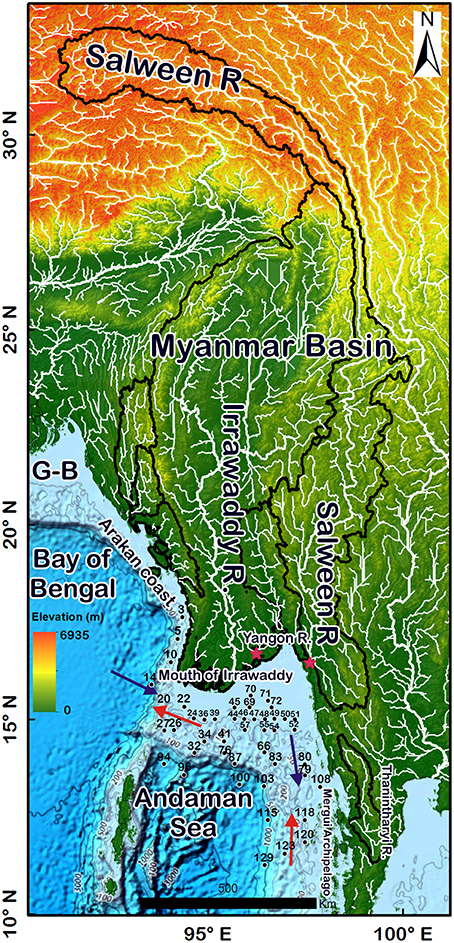
Figure 1. Sediment sampling locations over the Western Myanmar and Northern and Eastern Andaman Shelves including Digital Elevation Model (DEM). Elevation of the continents is in meters and bathymetry of the Andaman Sea is given along with contours. Major rivers bringing sediments to the Andaman Sea are also shown. Stars show locations of sediments collected from the mouths of the Irrawaddy and the Salween Rivers. Black lines demarcates the different catchments. Blue and red arrows represent the surface ocean currents in the Andaman Sea during south–west and north–east monsoons respectively. Numbers near the dots are sample numbers.
Tidal currents and the seasonally reversing monsoon currents strongly influence the sediment spreading on the Irrawaddy continental shelf (Figure 1; Wyrtki, 1973; Ramaswamy et al., 2004; Rao et al., 2005). The south–west (SW) monsoon is active during May–October and 80–90% of the annual Myanmar rainfall, runoff and sediment discharge occur during this period, whereas the north–east (NE) monsoon is active between December and February (Rodolfo, 1969; Rao et al., 2005). During the SW monsoon, Myanmar receives very high precipitation and at places it is highly intense and focused. The western slopes of the Indo–Burmese and Western/Central granitic ranges receive rainfall as high as 5 m/y (Figure 2). Higher precipitation in the catchment produces higher erosion and transport a large quantity of sediments to the Andaman Sea. The sediment fluxes of the Irrawaddy River to the Andaman Sea during 1966–1996 indicate significant yearly and monthly variations (Win, 2011) and most of these sediments are delivered to the sea during the SW monsoon period (Win, 2011). In response to the monsoons, the oceanic flow of surface waters in the Andaman Sea changes direction annually two times with a cyclonic flow in the spring and summer and anti-cyclonic flow for the rest of the year (Potemra et al., 1991). Surface current in the Andaman Sea flows east- and southward (blue arrows, Figure 1) during SW monsoon which reverses during NW monsoon (red arrows, Figure 1). Current and winds during the SW monsoon drive the surface ocean eastward transferring the turbid Irrawaddy discharge from the river's mouths.
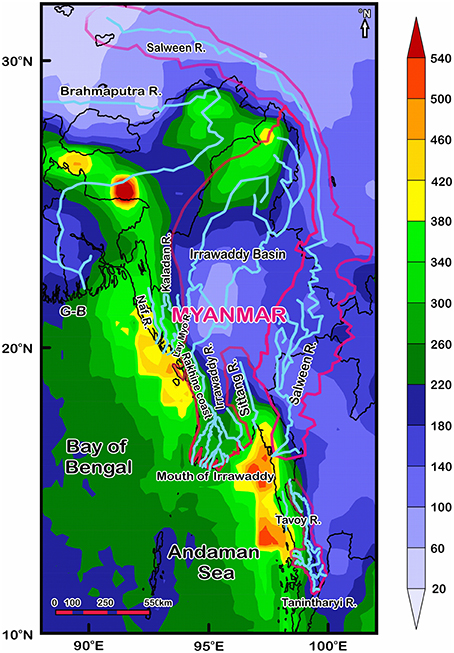
Figure 2. The average rainfall (cm/y) pattern for the 5 years (January 1998 to December 2002) over the present study area. Please note the intensely focused precipitation (~5 m/y) over the western slopes of the Indo–Burman–Arakan ranges along the Rakhine coast and over the western slope of Western/Central granitic ranges in Southern Myanmar (Source: http://trmm.gsfc.nasa.gov/).
The Irrawaddy continental shelf and the Gulf of Martaban are covered by a modern inner-shelf mud belt while relict sands and carbonates cover the outer shelf (Rodolfo, 1969; Rao et al., 2005). High suspended sediment in the Gulf of Martaban and Irrawaddy continental shelf is a continual feature due to macro-tidal setting (Ramaswamy et al., 2004). A significant fraction of the suspended sediment delivered by the Irrawaddy River is transported eastward and deposited in the Gulf of Martaban along with those brought by the Salween River. A smaller fraction is transported into the Eastern BoB between October and December. Transport of the suspended sediments as bottom flows directly into the deep Andaman Sea via the Martaban Canyon is also seen (Ramaswamy et al., 2004). Sediments deposited on the South−Eastern Andaman Shelf could be derived from the Southern Myanmar and the Western Thailand (Rodolfo, 1969).
Geology of the Catchment Area
The Northern and Eastern Andaman shelves receive sediments mainly through the Irrawaddy and Salween Rivers. The Irrawaddy is the major river originating in the Northern Myanmar with a catchment area of 4.1 × 105 km2 and debouching into the Andaman Sea (Robinson et al., 2007). The Chindwin is its major tributary which joins it in downstream Mandalay. The Salween River is much longer, ~2800 km, with a catchment area ~2.7 × 105 km2 (Robinson et al., 2007). It originates in the Tibetan Plateau, flows through Yunnan Province of China, the Kayan and the Mon States of Myanmar and debouches into the Gulf of Martaban in the Andaman Sea. Most of the sediments delivered to the Andaman Sea are brought by the Irrawaddy and the Salween Rivers. Smaller rivers such as the Kaladan, Naf, Lemro, Mayu, etc. flowing through the western slope of the Indo–Burman ranges along the Arakan (Rakhine) coast supply sediments to the western shelf of Myanmar, whereas smaller rivers of Southern Myanmar, such as the Heinze, Ye, Tavoy, Tanintharyi and the Lenya flowing through the mountains of Southern Myanmar and Western Thailand contribute sediments to the Eastern Andaman Shelf.
The rivers bringing sediments to the Andaman Shelf drain various lithologies in their catchments. The major lithologies these rivers drain are presented in Figure 3. The Irrawaddy River flows, in its upper reaches, through the Gangdese batholith, metamorphic rocks and ophiolites of possible eastern continuation of the Indus Tsangpo Suture Zone, the volcanics from a Cretaceous arc and sediments produced during the collision (Stephenson and Marshall, 1984; Maury et al., 2004; Najman et al., 2004; Szulc et al., 2006; Allen et al., 2008), associated post-collision intrusive igneous rocks (Darbyshire and Swainbank, 1988) and basic/ultrabasic rocks of the eastern syntaxis of the Himalaya. In the middle reaches, the Irrawaddy drains the Mogok Metamorphic Belt containing schists, gneisses, marble, migmatites, and calc-alkaline plutonics (Figure 3; Chapman et al., 2015). The catchment of the Irrawaddy River east of Mogok Metamorphic Belt comprises the older Palaeozoic sediments of the Asian Plate origin form the highlands of the Shan Plateau incorporating turbidites and carbonates. A significant part of the Irrawaddy basin lies in the Central Troughs (Eastern and Western Troughs, Figure 3) which comprises late Cretaceous and younger sediments with granite-granodiorite intrusions and alkaline andesite-dacite volcanoes. The Miocene granitic rocks extend from the south of Mandalay toward Western Thailand.
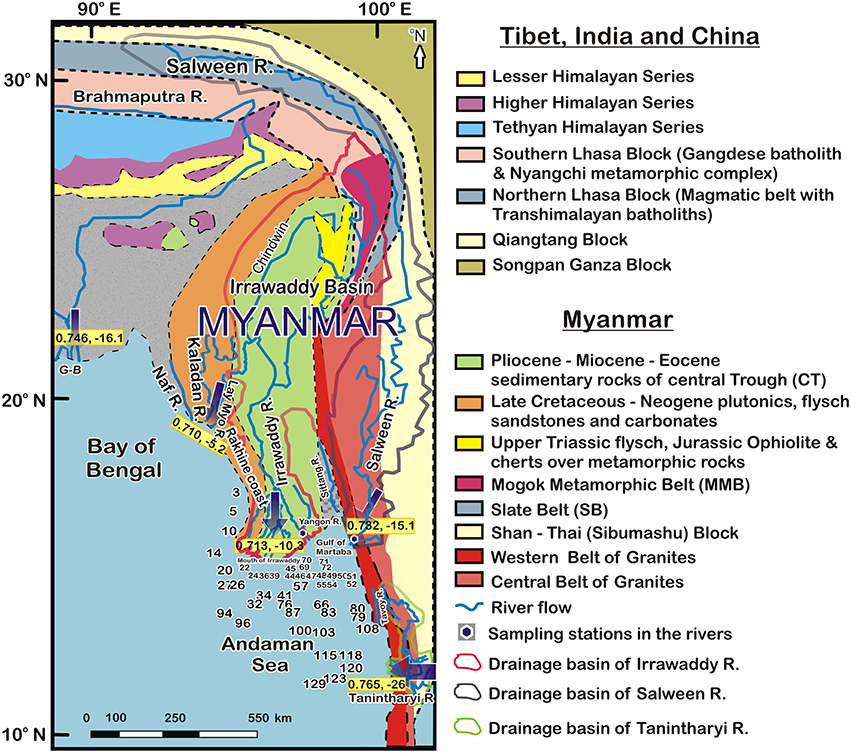
Figure 3. The lithology map of the drainages of the Irrawaddy, the Salween and the Tanintharyi River basins falling in the Tibet, China, and the Myanmar, modified after (Awasthi et al., 2014; Chapman et al., 2015).
Many of the rivers along the Arakan coast and the western tributaries of the Irrawaddy such as the Chindwin River drain the Indo–Burman hills comprising the Neogene and Paleogene sedimentary rocks, ophiolites, serpentinites and metamorphic rocks of Triassic to Cretaceous age (Figure 3). The Indo–Burman hills contain Cretaceous-Cenozoic forearc flysch (Allen et al., 2008).
The Salween River drains the magmatic belt with Trans-Himalayan batholith of the Northern Lhasa block and Precambrian to Tertiary sedimentary, igneous and metamorphic rocks of the Shan Plateau/Sibumashu block (Figure 3; Nakapadungrat et al., 1984).
Rivers such as the Tanintharyi and the Tavoy that drain the Southern Myanmar and Western Thailand flow through the Western and Central granitic belts (Figure 3; Nakapadungrat et al., 1984; Liew and McCulloch, 1985).
Materials and Methods
A total of 110 surface sediment samples were collected from the Northern Andaman Shelf region during the low river discharge period of April−May, 2002 onboard the 175th expedition of ORV Sagar Kanya (Figure 1; Ramaswamy et al., 2008). Geochemical elements, Sr, Nd concentrations and Sr-Nd isotopic compositions of about fifty sediment samples were investigated in this study. The sediments were dried in an oven at ~50°C and powdered to < 100 μm using an agate mortar and pestle. The geochemical elements abundances and Sr-Nd isotopic analyses of the samples were carried out in their silicate fractions. Toward this, the bulk samples (number of shelf sediments, n = 46) were decarbonated using 0.6N HCl and ashed at 600°C to oxidize the organic matter. These decarbonated and organic matter free samples were dissolved by repeated treatment of HF−HNO3−HCl acids (Potts, 1992). Abundances of major elements (e.g., Ca, Mg, Fe, Mn, Al, and Ti) in these solutions were measured using an ICP-AES (Horiba, Jobin-Yvon, Ultima), whereas Na and K were measured using Flame-AAS (Perkin-Elmer). SiO2 could not be determined as it got evaporated as SiF4 during the sample dissolution with HF followed by subsequent evaporation (Potts, 1992). A few samples were analyzed in replicate to determine the precision of measurements; these replicate measurements show that the analytical reproducibility of the geochemical analysis is better than 5 wt%. The accuracy of these measurements was ascertained by analyzing NIST standard SDO-1 and SCo-1 along with samples. Sr-Nd isotopic analyses in the silicate fractions were carried out following established analytical methodology at Physical Research Laboratory, Ahmedabad, India (Singh et al., 2008; Goswami et al., 2012). The silicate fraction of the samples, together with known amount of 84Sr spike was digested completely using HF−HNO3−HCl acids. Pure fractions of Sr and Nd were separated from the solution using conventional column chromatography (Singh et al., 2008). Measurements of Sr and Nd isotopes were carried out using Thermo Neptune MC-ICP-MS in static multi collection mode (Goswami et al., 2012). The isotope data were corrected for instrumental mass fractionation by normalizing the Sr and Nd isotopic data with 86Sr/88Sr (=0.1194) and 146Nd/144Nd (=0.7219) respectively. The Sr concentrations in samples were determined using isotope dilution whereas Nd contents were determined using standard calibration methods by QICP-MS (Thermo Xseries-2). During the course of this study, the measurement of isotopic composition of Sr and Nd of known international standards were also carried out. The average 87Sr/86Sr ratio of standard SRM 987 during these measurements, 0.710332 ± 0.000010; (1σ, n = 8) and 143Nd/144Nd for Merck Nd 0.511702 ± 0.000010; (1σ, n = 8) were found consistent with their published values. The total procedural blank for Sr and Nd for these analyses were found few orders of magnitude lower than Sr and Nd processed in samples and hence data were not corrected for blank. Along with shelf sediments, three riverine sediments, one from the Irrawaddy mouth and two from the Salween were also analyzed for their major, Sr, Nd elemental abundances and Sr and Nd isotope compositions following the above protocols.
Results
The Northern and Eastern Andaman Shelf sediment samples analyzed in this study are dominated by silt and clay fractions (Rodolfo, 1969; Rao et al., 2005; Ramaswamy et al., 2008) with coarser sand dispersed at places. The concentrations of major elements such as Na, K, Ca, Mg, Al, Fe, Mn, and Ti measured in silicate fraction of the shelf and river sediments are reported in Table 1. The relative abundances of these elements in the shelf sediments were observed in an increasing order, Mn < Ti < Ca < Na < Mg < K < Fe < Al. This trend originates in large extent from the earth crust through weathering. The concentrations of major elements display a large variation (Table 1). Al is the most abundant in most of the samples followed by Fe. Al and Fe vary from 0.5 to 13.1 wt% and 0.5 to 6.1 wt% respectively, which are within the typical range for rock forming minerals (Alagarsamy et al., 2010). A few sediment samples collected near the Mergui shelf along Southern Myanmar (Figure 1) contain lower content of Al and other elements probably due to the dominance of quartz in them. Ca varies from 0.07 to 0.94 wt% in these de-carbonated samples. Al and Fe contents in Irrawaddy River sediment are high, 12 and 6 wt% respectively whereas they are ~6 and 3 wt% respectively in Salween River sediments. The concentrations and isotopic compositions of Sr and Nd of shelf and river sediments are presented in Table 1. The ranges of Sr and Nd concentrations are 10–162 μg/g and 2.4–38.6 μg/g respectively and are generally lower or comparable to the values reported for Irrawaddy, Salween, and Ganga–Brahmaputra (G–B) River sediments (Colin et al., 1999; Singh et al., 2008). The 87Sr/86Sr and εNd values of shelf sediments vary from 0.712245 to 0.742183 and −6.29 to −17.25 respectively. Higher εNd values were found for samples from the Western Myanmar coast, which usually have low 87Sr/86Sr. Sediments collected from Mergui shelf region have most radiogenic Sr and least radiogenic Nd, similar to those reported in the Ganga–Brahmaputra Rivers (Galy and France-Lanord, 2001). Sediments from off Salween River contain higher 87Sr/86Sr and lower εNd. Sr and Nd isotope compositions of sediments collected from the Gulf of Martban are intermediate to the two extremes defined by sediments of the Arakan (Rakhine) coast and that of the Salween mouth and the Mergui shelf. The Irrawaddy and the Salween River sediments have contrasting Sr and Nd isotope composition; Irrawaddy has lesser radiogenic Sr and more radiogenic Nd when compared to that of the Salween. Sr and Nd isotope compositions of the Salween sediments are comparable to that of the lower Meghna (Combined Ganga and Brahmaputra, G–B) in Bangladesh (Galy and France-Lanord, 2001).
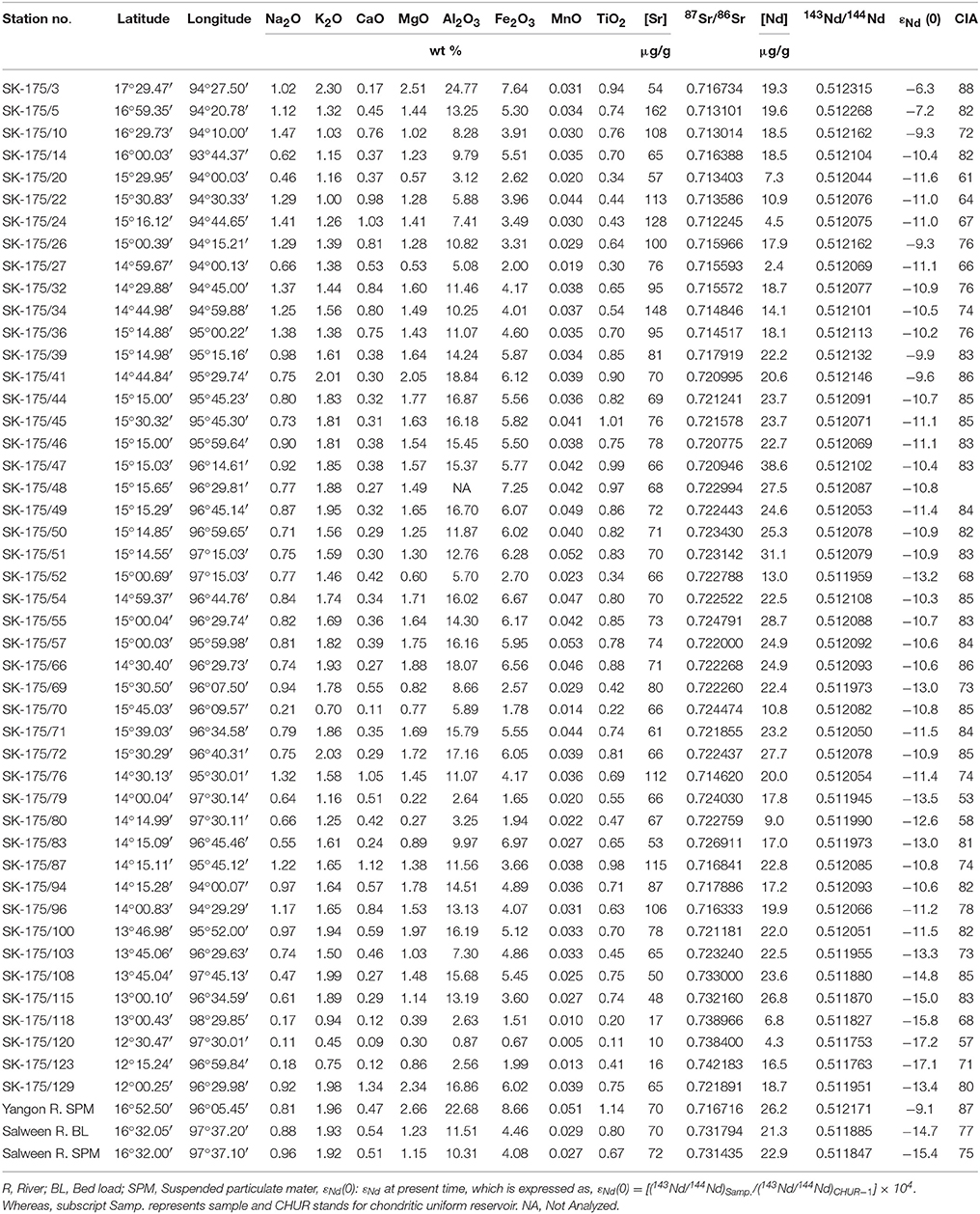
Table 1. Sample locations, major element compositions, concentrations, and isotope compositions of Sr and Nd and Chemical Index of Alteration (CIA) in surface sediment samples from the Irrawaddy continental shelf, Northern Andaman Sea and the Irrawaddy and the Salween Rivers.
Discussion
Major Element Compositions and Implications for Provenance
In this study chemical composition has been determined in the silicate fraction of the sediments. Al and Fe display large variability in these sediments. Part of these variabilities result from their source effect whereas weathering and size sorting introduce a part of it. Al in these sediments varies linearly with K, Mg, Fe, and Ti with a correlation coefficient (r for number of samples n = 46) 0.79, 0.86, 0.74, and 0.73 respectively, however, there is a very poor correlation of Al with Na (r = 0.31 for n = 46) and Ca (r = 0.01 for n = 46). These correlations could be due to the dominance of ferromagnesian silicates in the source regions followed by weathering and transport causing loss of mobile element sand size sorting. The statistically significant relationship between iron and aluminum suggests that iron oxides are not important since Fe is associated with aluminum in aluminosilicate phases (Alagarsamy et al., 2010). Lack of correlation of Ca and Na with Al in these sediments results from preferential loss of these mobile elements with respect to Al during chemical weathering. Ti is very less abundant but shows a significant positive correlation with Al due to similar source, chemical behavior, and size sorting. K is more abundant in feldspar and illite so that the variations in the K/Al ratio may reflect the variations in feldspar and illite abundances present in the sediments due to inherent source signature or due to weathering and transport. Higher K concentration shows more feldspar and illite (Colin et al., 1999; Singh et al., 2008) in these sediments. On FM-CN-K (Fe2O3+ MgO − CaO + Na2O − K2O) diagram (Figure 4A) a large number of samples plot toward FM apex confirming their ferromagnesian affinity which is further supported by good positive correlation (r = 0.81 for n = 46) between Fe and Mg. Mafic rocks such as basalts/ophiolites present in the drainage of the upper Irrawaddy catchment, in the central trough and in the Indo–Burman–Arakan (IBA) ranges could be an important source of sediments to the Andaman Shelf even though they occupy only small fraction of the Irrawady catchment. On A-CN-K (Al2O3 − CaO + Na2O − K2O) ternary plot (Figure 4B) the majority of samples of the Andaman Shelf plot parallel to A-CN join, indicating progressive chemical weathering of the samples originating from mafic compositions. Variable chemical weathering of these sediments is also reflected by their variable Chemical Index of Alteration (CIA = [Al2O3/(Na2O + K2O + CaO + Al2O3)] × 100; Nesbitt and Young, 1982). CIA values of the Andaman Shelf sediments range between 53 and 88% (Table 1), suggesting significant variation in their chemical weathering. Few samples collected around the Mergui Shelf region contain very low concentrations of all the major elements analyzed in this study; this could be due to the fact that they are coarse-grained sands (Rodolfo, 1969) mostly dominated by quartz.
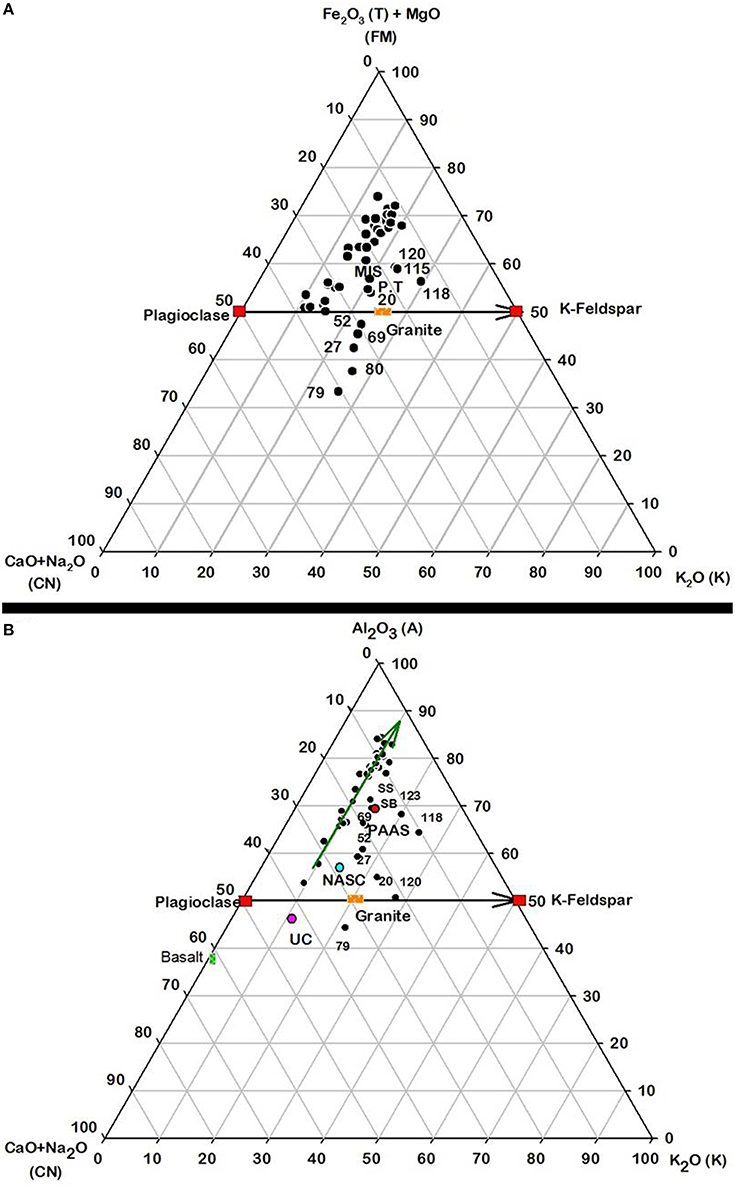
Figure 4. (A) FM-CN-K and (B) A-CN-K ternary plots of Andaman Shelf sediments. Numbers within the ternary plots indicate the sample numbers. Values for the basalts, granites, Upper crust (UC), Post-Archean Australian Shale (PAAS) and Noth American Shale Composite (NASC) are also plotted (Taylor and McLennan, 1985). The FM-CN-K plot suggests mafic lithology as the dominant source of the majority of the sediments which have undergone through variable chemical weathering evolving toward Al2O3 apex (A-CN-K plot).
Provenance Tracing Using Sr and Nd Isotopic Systematics
Sr and Nd concentrations and their isotope compositions in the Andaman Shelf sediments were analyzed in their silicate phases. 87Sr/86Sr ratios in these sediments show significant variations, ranging between 0.712245 and 0.742183. Their Sr concentrations lie between 10 and 162 μg/g. Nd concentrations and εNd(0) in these shelf sediments vary from 2.4 to 38.6 μg/g and −6.29 to −17.25 respectively. 87Sr/86Sr ratios of surface-slurry and bank sediments at the mouth of the Salween River are 0.731794 and 0.731435 with Sr concentrations, 70 and 72 μg/g and their εNd(0) are −14.69 and −15.43 with Nd concentrations, 21.3 and 22.9 μg/g respectively. Sediment collected at the mouth of the Yangon River, a distributary of the Irrawaddy River has 87Sr/86Sr ratios and εNd(0) 0.716716 and −9.11 with their Sr and Nd concentrations 70 and 26.2 μg/g respectively. Majority of the samples from the Andaman Shelf have 87Sr/86Sr ratios between 0.712245 and 0.733000 and εNd(0), −9.11 and −15.43 with Sr and Nd concentrations around 75 μg/g and 25 μg/g respectively. Few samples collected close to Arakan Coast have lower 87Sr/86Sr ratios, 0.716734−0.713101 and higher radiogenic Nd, εNd(0) values −6.29 to −7.21 respectively, reflecting their Indo–Burman ranges association (Licht et al., 2013). A few samples collected close to Mergui Archipelago have high radiogenic 87Sr/86Sr ratios, 0.738400−0.742183 and low εNd(0), −15.82 to −17.25. These radiogenic Sr and non-radiogenic Nd are similar to those reported for the sediments of delta region of the Lower Meghna (combined G–B; Galy and France-Lanord, 2001), however, it is quite unlikely to get G–B sediments at this location, this region being very far from the G–B reaches and lying away from their sediment transport pathways.
87Sr/86Sr ratio and εNd of sediments from the various river and ocean basins have been used successfully to track their sources (Goldstein and O'Nions, 1981; Bouquillon et al., 1990; France-Lanord et al., 1993; Galy et al., 1996, 2010; Winter et al., 1997; Pierson-Wickmann et al., 2001; Clift et al., 2002; Singh and France-Lanord, 2002; Banner, 2004; Ahmad et al., 2005, 2009; Colin et al., 2006; Singh et al., 2008; Viers et al., 2008; Rahaman et al., 2011; Tripathy et al., 2011; Goswami et al., 2012; Awasthi et al., 2014; Ali et al., 2015). These isotope pairs are used as reliable proxies to track the sediment sources, as there are distinct differences in their composition in the different lithologies supplying these sediments. However, successful tracking of the sediment sources using Sr-Nd isotope pair depends to a great extent on their preservation during their weathering and transport. Weathering and transport of the sediments may influence the isotope composition of Sr compared to that of Nd due to mobile nature of the former, making the Nd isotope composition more robust provenance tracer (Walter et al., 2000; Tutken et al., 2002). Robustness of Sr and Nd isotope compositions in tracking the sediment sources in the Andaman Shelf can be verified by observing their relation with Al and chemical index of alteration (CIA) as they get influenced by the processes of size sorting and chemical weathering respectively which might affect the isotope composition of Sr and Nd of these sediments (Singh et al., 2008). 87Sr/86Sr and εNd of the sediments of Andaman Shelf have been plotted with their Al contents and CIA in Figures 5A–D. These scatter plots do not show any interrelation among Sr-Nd isotope composition, Al contents and CIA of the sediments, suggesting the minimal influence of weathering and transport on these isotope compositions and hence they can be used quite reliably to track the sources of these sediments.
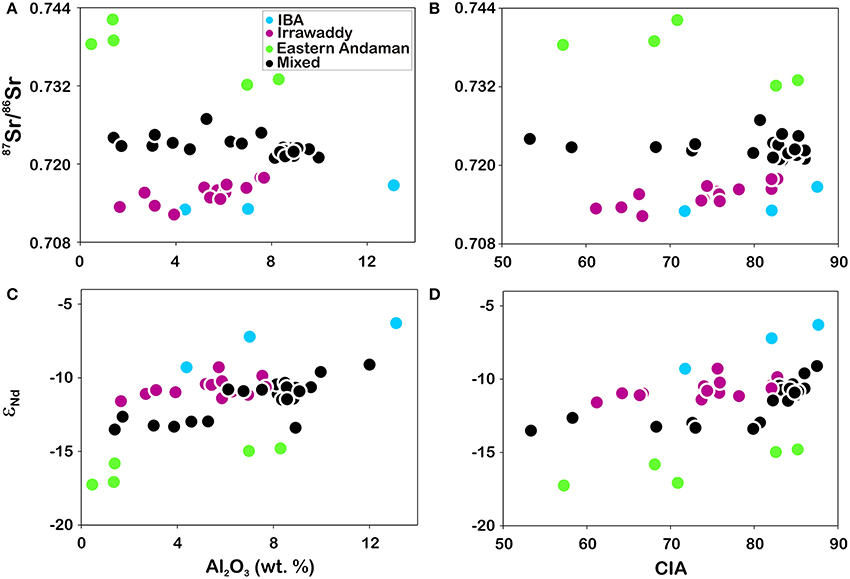
Figure 5. Scatter plot of 87Sr/86Sr and εNd with Al2O3 (wt. %; A,C) and CIA (B,D) of the shelf sediments. The absence of any correlations (r = 0.04–0.5 for n = 46) among them suggests that Sr and Nd isotope compositions of these sediments are not influenced by size sorting and chemical weathering and hence can be used as good proxies to constrain their sources.
Figures 6A,B shows the distribution patterns of 87Sr/86Sr ratios and εNd in the Andaman Shelf. These distribution patterns show three distinct zones with their characteristic Sr-Nd isotope signatures. The first zone, comprising the Western Myanmar Shelf region along Arakan Coast and around the mouth of the Irrawaddy River, is characterized by lower 87Sr/86Sr and higher εNd. This zone probably gets sediments through Kaladan, Naf and other smaller rivers draining the IBA ranges having 87Sr/86Sr ratios, 0.714 − 0.718 and εNd(0), −7.8–−3.9 (Licht et al., 2013) and through Irrawaddy Rivers. The second zone is the area around the mouth of the Salween River with higher 87Sr/86Sr and lower εNd and gets sediments from the Salween River. The third zone is characterized by distinctly high 87Sr/86Sr and low εNd around the Mergui Archipelago in the Southern Myanmar. The Sr-Nd isotope compositions of these sediments is very similar to those of the Lower Meghna (Galy and France-Lanord, 2001). The sediments from the GBR system may come to the Andaman Shelf and to the Mergui Archipelago region through the North/South Preparis Channel. It is, however, very difficult to envisage GBR sediments reaching such far a location without impacting the sediments of shelf region around the mouth of the Irrawaddy. Eastern Andaman Shelf sediments do not show affinity with those from the Irrawaddy and the Salween Rivers either. These sediments, therefore, require another source. Close inspection of lithologies around the Mergui Archipelago and very few available isotope data for them suggest that the granites from the Central and Western belts with higher 87Sr/86Sr and lower εNd (Nakapadungrat et al., 1984; Liew and McCulloch, 1985) present in the Southern Myanmar and Western Thailand could be the possible source of these sediments. The Tanintharyi, Tavoy and other smaller rivers flowing these granitic belts could possibly be bringing sediments around the Mergui Archipelago. Part of sediments in this region might originate from the erosion of several small islands of the Mergui Archipelago itself. Granites of the Southern Myanmar and Western Thailand were not known to be a major source of sediments to the Andaman Shelf earlier. This study however, identifies these granitic belts as an important source of sediments to the Eastern Andaman Shelf in Southern Myanmar.
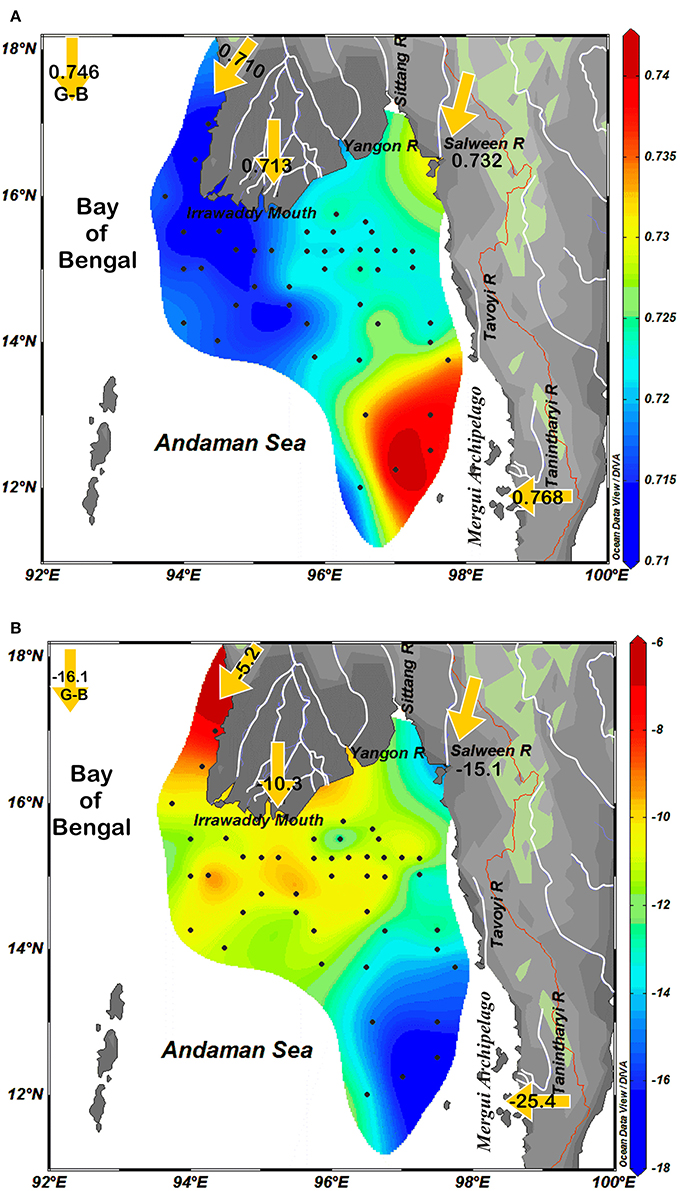
Figure 6. Distribution patterns of (A) 87Sr/86Sr and (B) εNd in the Western Myanmar, Northern and Eastern Andaman Basin. Both these patterns indicate four dominant sources of sediments, (i) rivers from the Arakan Coast, (ii) The Irrawaddy River, (iii) the Salween River, and (iv) the Tanintharyi and other smaller rivers draining Southern Myanmar.
To further identify the sources of sediments of the Andaman Shelf, their Sr and Nd isotope compositions have been plotted on two isotopes mixing diagram (Figure 7). There could be five potential sources of sediments of the Andaman Shelf: (i) Rivers draining the IBA Ranges with low 87Sr/86Sr and high εNd, (ii) Irrawaddy River with low 87Sr/86Sr and high εNd, (iii) Salween River with higher 87Sr/86Sr and low εNd, (iv) G–B river system with high 87Sr/86Sr and low εNdand (v) Rivers draining the Southern Myanmar and Western Thailand with high 87Sr/86Sr and low εNd. The Sr and Nd isotope compositions of the possible dominant end-members (Table 2) are also plotted. The isotope compositions of these end-members (Table 2) are assigned based on those available in the literatures and based on few samples of the Irrawaddy and the Salween Rivers analyzed this study. Due to lack of study in Myanmar and adjoining areas, isotope values of some of the end-members need to be fixed either using the few available data or indirectly. There is no data available on the smaller rivers flowing through the western slopes of the IBA ranges along the Arakan Coast. Sr-Nd isotope compositions for the lithologies present in Indo–Burman ranges (Licht et al., 2013) have been considered for these rivers (Colin et al., 1999). Sr, Nd isotope compositions of two sediment samples of unknown locations of the Irrawaddy River is available in the literature (Colin et al., 1999; Allen et al., 2008). In this study, one sediment sample from the mouth of the Yangon, one of the distributaries of the Irrawaddy River, was analyzed for its Sr and Nd isotope compositions which are consistent with the earlier reported values. Irrawaddy end-member is based on these three data (Table 2). The Salween end-member is characterized by Sr and Nd isotope composition of two sediment samples collected from its mouth and analyzed in this study (Table 2). The Sr isotope value of this end-member is supported by high 87Sr/86Sr observed in granites present in its catchment (Nakapadungrat et al., 1984). Fixing the end-member values for sediments brought by the Tanintharyi, the Tavoy and other smaller rivers in Southern Myanmar was difficult as these rivers have never been analyzed and data are not available. As these rivers mostly flow through the Western/Central granitic belts (Figure 2), the few data available on these granites on Sr and Nd isotopes from the Southern Myanmar and Western Thailand (Nakapadungrat et al., 1984; Liew and McCulloch, 1985) have been used to constrain this end-member (Table 2). The end-member values of the Ganga–Brahmaputra River is based on the data of the Lower Meghna (Galy and France-Lanord, 2001).
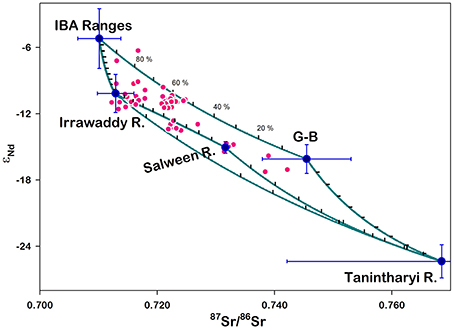
Figure 7. Binary mixing plot of Sr and Nd isotope composition of the sediments of the Andaman Shelf. Sr and Nd isotope compositions of the potential end-members are also shown. For details about these end-members please see the text. This plot suggests that majority of the sediments to the Andaman Shelf are derived from the Irrawaddy river along with the Salween and rivers flowing through the western slopes of the Indo–Burman–Arakan and Western/Central granitic ranges. Blue curve represents the hyperbolic two end member mixing curve where as ticks on them indicate the fractions of the end members.
On the Sr-Nd isotope mixing diagram (Figure 7), samples collected from the shelf area along Arakan Coast show an affinity toward IBA end-member suggesting that the rivers such as the Kaladan, Naf and other small rivers flowing through the Arakan Coast deliver sediment to the near by shelf. Impact of the G–B river system on the Western Myanmar Shelf sediments seems to be quite minimal, if any, despite their proximity with the G–B delta. The eastward surface current flowing from the G–B delta toward this shelf is unable to bring an appreciable amount of sediments from the G–B delta to the Western Myanmar Shelf. Sr and Nd isotope composition of several samples plot near the Irrawaddy end-member suggest that this river is the major source of sediments to the Andaman Shelf. Sediments from the Gulf of Martban are a mixture of sediments derived from the Irrawaddy and the Salween Rivers in more or less an equal proportion. Further south–east, near the mouth of the Tavoy River, sediments of the Irrawaddy origin are still present, though in lesser fraction compared to the Gulf of Martban. Sediments from the shelf around the South Myanmar are quite unique. They have high 87Sr/86Sr and low εNd, similar to those from the G–B river system in the Bangladesh. As discussed above, G–B sediments cannot reach near the Mergui Archipelago and majority of these sediments are derived from the erosion of the granitic belts from the Southern Myanmar and Western Thailand. These are a mixture of sediments derived from the Tanintharyi, the Irrawaddy, and the Salween Rivers. It is almost clear from Figures 6, 7 that G–B river system contributes very little sediments to the Andaman Shelf. It is unlikely that Bengal shelf sediments are reaching the Andaman Shelf in recent times.
Control on Erosion Determining the Sediment Sources
It is borne out from the above discussion that majority of the sediments in the Andaman Shelf are derived from (i) the Irrawaddy River, (ii) the Salween River, (iii) IBA ranges through the rivers of the Arakan Coast and (iv) Central and Western granite belts in the Southern Myanmar and Western Thailand through the Tavoy, the Tanintharyi and other smaller rivers (Figure 1). Large sediment supply from the IBA ranges through smaller rivers of western slopes of the IBA and through the Irrawaddy and Southern/Western granitic belts suggest significantly higher erosion rates over them. Observation of high erosion over the IBA ranges was suggested earlier by Colin et al. (1999). However, high erosion over the Western/Central granitic belt is reported for the first time in this study. Higher erosion over these two ranges seems to be controlled by the intense and focussed precipitation and topography (relief). Annual rainfall over the IBA and Western/Central granite ranges is as high as 5 m (Figure 2), much higher compared to other regions providing sediments to the Andaman Shelf. Most of this rainfall occurs during the south–west monsoon. Further, the high and focussed precipitation coincides with higher relief on western slopes (Figure 8) of these ranges. Rainfall and elevation along the transects following the SW monsoon tracks, two over the IBA and one over the Southern/Western granite ranges are plotted in the Figure 8. Along all these sections, high and focussed precipitation coincides with higher relief along the western slopes of these ranges causing higher stream power leading to higher erosion. Such higher erosion due to focussed precipitation on higher relief on the southern slopes of the Higher Himalaya has been reported earlier too (Singh and France-Lanord, 2002; Hodges et al., 2004; Thiede et al., 2004; Wobus et al., 2005; Singh, 2006; Singh et al., 2008). Thus, the sediment budget of the Andaman Shelf, in addition to the Himalayan–Tibetan ranges, is controlled by erosion over the Indo–Burman–Arakan and Western/Central granitic ranges due to intense and focussed precipitation over the higher relief of their western slopes.
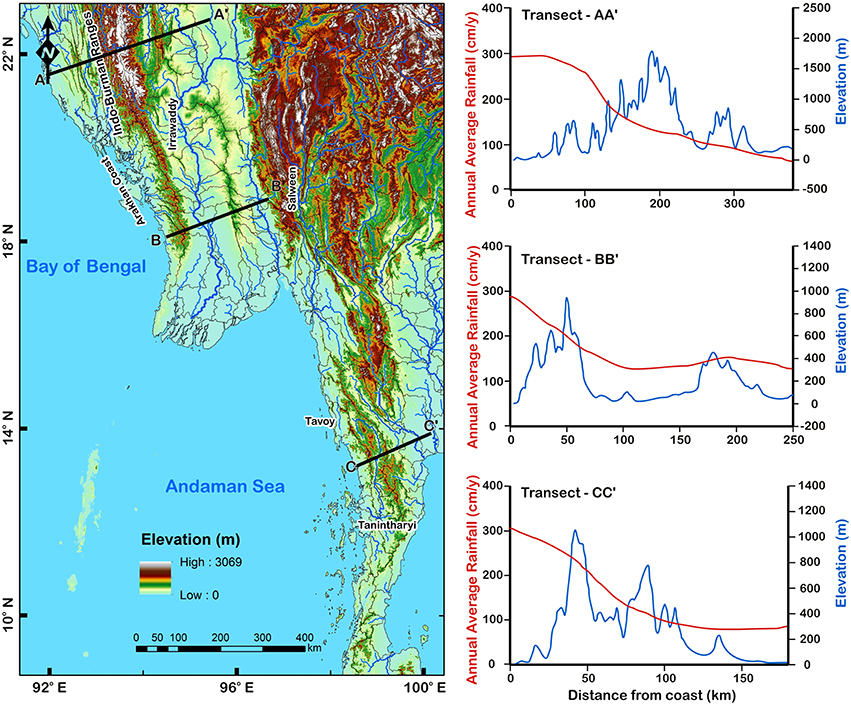
Figure 8. Precipitation and elevation plotted along the three transects shown on DEM map following the SW monsoon track. Intense and focused precipitations over the higher relief of the western slopes of the IBA (Transects AA′, BB′) and Western/Central granitic ranges (Transect CC′) cause higher erosion in these catchment (Source: http://dwtkns.com/srtm/ and http://trmm.gsfc.nasa.gov/).
Role of Sea-Surface Current in Controlling the Sediment Dispersion
The sea-surface current of the Andaman sea observes two reversal. It flows eastward during SW monsoon and westward during NE monsoon (Figure 1). As most of the precipitation occur during the south–west monsoon causing higher erosion leading to ~90% of annual sediment discharge, therefore eastward current from the BoB and from the shelf along the Arakan Coast brings sediments to the Northern Andaman Shelf which mix with sediment brought by the Irrawaddy River and get deposited on the shelf. These sediments get transported further eastward and mix with sediments from the Salween and get deposited in Gulf of Martban and on the eastern shelf (Figure 1). These currents bring sediments from the Irrawaddy and the Salween Rivers further to the south which get deposited after mixing with sediments brought by the Tavoy and the Taninthrayi Rivers. During the north–east monsoon the sea-surface current in the Andaman Sea reverses and flows westward (Figure 1). However, low precipitation during NE monsoon leads to less erosion in the catchment and hence lower sediment delivery to the shelf. Part of the sediments deposited on this shelf during SW monsoon get transported westward to the Eastern BoB during NE monsoon (Colin et al., 1999; Ramaswamy et al., 2004).
Conclusion
Major element and Sr and Nd concentrations and their isotope compositions have been determined in the silicate fraction of the sediments deposited on the Northern and Eastern Andaman Shelf to constrain their sources and factors influencing their erosion, dispersal, and deposition. Major element compositions of the majority of these sediments indicate their ferromagnesian nature which is sourced from mafic lithologies present in the drainage of the Irrawaddy River and over the IBA. Sr and Nd isotope compositions of Andaman Shelf sediments suggest that these sediments are mostly derived from (i) the Irrawaddy River, (ii) the Salween River, (iii) the IBA ranges either through the smaller rivers flowing through the Arakan coast or through the Irrawaddy River whose western tributaries such as the Chindwin etc. draining these ranges and (iv) the Western/Central granitic belts of the Myanmar and Thailand through the Tavoy, the Tanintharyi and other smaller rivers. The erosion and sediment delivery from these sources are controlled by the intense and focussed precipitation over the high relief on the western slopes of these ranges and further dispersed by the eastward sea-surface current controlled by SW monsoon on the Northern and Eastern Andaman Shelf. This study for the first time recognizes the higher erosion on the western slopes of the granitic ranges of the Southern Myanmar, supplying a significant amount of sediment to the Eastern Andaman Shelf around the Mergui Archipelago.
Author Contributions
SS and KD planned the experiment wrote the manuscript. VR and PR collected the samples. KD conducted the experiments and VR helped in isotope measurements. All authors contributed in interpreting the data.
Conflict of Interest Statement
The authors declare that the research was conducted in the absence of any commercial or financial relationships that could be construed as a potential conflict of interest.
Acknowledgments
KD thanks Ravikant Prasad and Mithun M. for their help in refining DEM and precipitation figures. We sincerely thank Selvaraj Kandasamy, the associate editor for his positive feedback on this manuscript. Detailed reviews of Liviu Giosan, Ludvig Löwemark and Armstrong-Altrin John S. helped improve this manuscript considerably.
References
Ahmad, S. M., Anil Babu, G., Padmakumari, V. M., Dayal, A. M., Sukhija, B. S., and Nagabhushanam, P. (2005). Sr, Nd isotopic evidence of terrigenous flux variations in the Bay of Bengal: implications of monsoons during the last ~34,000 years. Geophys. Res. Lett. 32:L22711. doi: 10.1029/2005GL024519
Ahmad, S. M., Padmakumari, V. M., and Anil Babu, G. (2009). Strontium and neodymium isotopic compositions in sediments from Godavari, Krishna and Pennar rivers. Curr. Sci. 97, 1766–1769.
Alagarsamy, R., You, C.-F., Nath, B. N., and Sijin Kumar, A. V. (2010). Determination of rare earth, major and trace elements in authigenic fraction of Andaman Sea (Northeastern Indian Ocean) sediments by Inductively Coupled Plasma-Mass Spectrometry. Microchem. J. 94, 90–97. doi: 10.1016/j.microc.2009.09.007
Ali, S., Hathorne, E. C., Frank, M., Gebregiorgis, D., Stattegger, K., Stumpf, R., et al. (2015). South Asian monsoon history over the past 60 kyr recorded by radiogenic isotopes and clay mineral assemblages in the Andaman Sea. Geochem.Geophys. Geosyst. 16, 505–521. doi: 10.1002/2014GC005586
Allen, R., Najman, Y., Carter, A., Barfod, D., Bickle, M. J., Chapman, H. J., et al. (2008). Provenance of the Tertiary sedimentary rocks of the Indo-Burman Ranges, Burma (Myanmar): Burman arc or Himalayan-derived? J. Geol. Soc. Lond. 165, 1045–1057. doi: 10.1144/0016-76492007-143
Awasthi, N., Ray, J. S., Singh, A. K., Band, S. T., and Rai, V. K. (2014). Provenance of the Late Quaternary sediments in the Andaman Sea: implications for monsoon variability and ocean circulation. Geochem. Geophys. Geosyst. 15, 3890–3906. doi: 10.1002/2014GC005462
Banner, J. L. (2004). Radiogenic isotopes: systematics and applications to earth surfaceprocesses and chemical stratigraphy. Earth Sci. Rev. 65, 141–194. doi: 10.1016/S0012-8252(03)00086-2
Bird, M. I., Robinson, R. A. J., Oo, N. W., Aye, M. M., Lud, X. X., Higgitt, D. L., et al. (2008). A preliminary estimate of organic carbon transport by the Ayeyarwady (Irrawaddy) and Thanlwin (Salween) Rivers of Myanmar. Quat. Int. 186, 113–122. doi: 10.1016/j.quaint.2007.08.003
Bouquillon, A., France-Lanord, C., Michard, A., and Tiercelin, J. J. (1990). Sedimentology and isotopic chemistry of the Bengal fansediments: the denudation of the Himalaya. Proc. Ocean Drill. Prog. Sci. Results 116, 43–58.
Chapman, H., Bickle, M., Thaw, S. H., and Thiam, H. N. (2015). Chemical fluxes from time series sampling of the Irrawaddy and Salween Rivers, Myanmar. Chem. Geol. 401, 15–27. doi: 10.1016/j.chemgeo.2015.02.012
Clift, P. D., Lee, J. I., Hildebrand, P., Shimizu, N., Layne, G. D., Blusztajn, J., et al. (2002). Nd and Pb isotope variability in the Indus River system: Implicationsfor sediment provenance and crustal heterogeneity in theWestern Himalaya. Earth Planet. Sci. Lett. 200, 91–106. doi: 10.1016/S0012-821X(02)00620-9
Colin, C., Turpin, L., Bertaux, J., Desprairies, A., and Kissel, C. (1999). Erosional history of the Himalayan and Burman ranges duringthe last two glacial–interglacial cycles. Earth Planet. Sci. Lett. 171, 647–660. doi: 10.1016/S0012-821X(99)00184-3
Colin, C., Turpin, L., Blamart, D., Frank, N., Kissel, C., and Duchamp, S. (2006). Evolution of weathering patterns in the Indo-Burman Ranges over the last 280 kyr: effects of sediment provenance on 87Sr/86Sr ratios tracer. Geochem. Geophys. Geosyst. 7:Q03007. doi: 10.1029/2005GC000962
Darbyshire, D. P. F., and Swainbank, I. G. (1988). Geochronology of a Selection of Granites from Burma. NERC Isotope Geology Centre Report 88/006.
France-Lanord, C., Deny, L. A., and Michard, A. (1993). Evolution of the Himalaya since Miocene time: isotopic and sedimentological evidence from the Bengal Fan. Himalayan Tectonic. Geol. Soc. Spec. Pub. 74, 603–621. doi: 10.1144/GSL.SP.1993.074.01.40
France-Lanord, C., and Derry, L. A. (1997). Organic carbon burial forcing of the carbon cycle from Himalayan erosion. Nature 390, 65–67. doi: 10.1038/36324
Galy, A., and France-Lanord, C. (2001). Higher erosion rates in the Himalaya: Geochemical constraintson riverine fluxes. Geology 29, 23–26. doi: 10.1130/0091-7613(2001)029%3C0023:HERITH%3E2.0.CO;2
Galy, A., France-Lanord, C., and Deny, L. A. (1996). Oligo-Miocène uplift and unroofing of the Himalaya: evidence from the Bengal Fan. Tectonophysics 260, 109–118. doi: 10.1016/0040-1951(96)00079-0
Galy, V., France-Lanord, C., Peucker-Ehrenbrink, B., and Huyghe, P. (2010). Sr–Nd–Osevidence for a stable erosion regime in the Himalaya during thepast 12 Myr. Earth Planet. Sci. Lett. 290, 474–480. doi: 10.1016/j.epsl.2010.01.004
Goldstein, S. L., O'Nions, R. K., and Hamilton, P. J. (1984). ASm-Nd isotopic study of atmospheric dusts and particulatesfrom major river systems. Earth Planet. Sci. Lett. 70, 221–236.
Goldstein, S. L., and O'Nions, R. K. (1981). Nd and Sr isotopic relationships in pelagic clays and ferromanganese deposits. Nature 292, 324–327. doi: 10.1038/292324a0
Goswami, V., Singh, S. K., Bhushan, R., and Rai, V. K. (2012). Temporal variations in87Sr/86Sr and εNd in sediments of the southeastern Arabian Sea: impact of monsoonand surfacewater circulation. Geochem. Geophys. Geosyst. 13:Q01001. doi: 10.1029/2011GC003802
Hodges, K. V., Wobus, C., Ruhl, K., Schildgen, T., and Whipple, K. (2004). Quaternary deformation, river steepening, and heavy precipitation at the front of the Higher Himalayan ranges. Earth Planet. Sci. Lett. 220, 379–389. doi: 10.1016/S0012-821X(04)00063-9
Licht, A., France-Lanord, C., Reisberg, L., Fontaine, C., Soe, A. N., and Jaeger, J.-J. (2013). A palaeo Tibet-Myanmar connection? Reconstructing the Late Eocene drainage system of central Myanmar using a multi-proxy approach. J. Geol. Soc. Lond. 170, 929–939. doi: 10.1144/jgs2012-126
Liew, T. C., and McCulloch, M. T. (1985). Genesis of granitoid batholiths of Peninsular Malaysiaand implications for models of crustal evolution: evidence from aNd-Sr isotopic and U-PI, zircon study. Geochim. Cosmochim. Acta 49, 587–600. doi: 10.1016/0016-7037(85)90050-X
Maury, R. C., Pubellier, M., Rangin, C., Wulput, L., Cotten, J., Socquet, A., et al. (2004). Quaternary calc-alkaline and alkaline volcanism inan hyper-oblique convergence setting, central Myanmar and western Yunnan. Bull. Soc. Géol. France 175, 461–472. doi: 10.2113/175.5.461
Najman, Y., Johnson, C., White, N. M., and Oliver, G. (2004). Evolution of the Himalayan foreland basin, NW India. Basin Res. 16, 1–24. doi: 10.1111/j.1365-2117.2004.00223.x
Najman, Y., Bickle, M., BouDagher-Fadel, M., Cater, A., Garzanti, E., Paul, M., et al. (2008). The Paleogene record of Himalayan erosion: Bengal Basin, Bangladesh. Earth Planet. Sci. Lett. 273, 1–14. doi: 10.1016/j.epsl.2008.04.028
Nakapadungrat, S., Beckinsale, R. D., and Suensilpong, S. (1984). “Geochronology and geology of Thai granites,” in Proceedings of the Conference on Applications of Geology and the National Development: Chulalongkorn University (Bangkok), 75–93.
Nesbitt, H. W., and Young, G. M. (1982). Early Proterozoic climates and plate motions inferred from major element chemistry of lutites. Nature 299, 715–717. doi: 10.1038/299715a0
Pierson-Wickmann, A.-C., Reisberg, L., France-Lanord, C., and Kudrass, H. R. (2001). Os-Sr-Nd results from sedimentsin the Bay of Bengal: implications for sedimenttransport and the marine Os record. Paleoceanography 16, 435–444. doi: 10.1029/2000PA000532
Potemra, J. T., Luther, M. E., and O'Brien, J. J. (1991). The seasonal circulation of theupper ocean in the Bay of Bengal. J. Geophys. Res. 96, 12667–12683. doi: 10.1029/91JC01045
Potts, P. J. (1992). A Handbook of Silicate Rock Analysis. Milton Keynes: Blackie & Son Ltd. doi: 10.1007/978-1-4615-3270-5
Rahaman, W., Singh, S. K., and Rajiv, S., and Tandon, S. K. (2011). Sr, C and O isotopes in carbonate nodules from the Ganga Plain: evidence for recentabrupt rise in dissolved 87Sr/86Sr ratios of the Ganga. Chem. Geol. 285, 184–193. doi: 10.1016/j.chemgeo.2011.04.003
Ramaswamy, V., Gaye, B., Shirodkar, P. V., Rao, P. S., Chivas, A. R., Wheeler, D., et al. (2008). Distribution and sources of organic carbon, nitrogen and their isotopicsignatures in sediments from the Ayeyarwady (Irrawaddy) continental shelf, northern Andaman Sea. Mar. Chem. 111, 137–150. doi: 10.1016/j.marchem.2008.04.006
Ramaswamy, V., Rao, P. S., Rao, K. H., Thwin, S., Rao, N. S., and Raiker, V. (2004). Tidalinfluence on suspended sediment distribution and dispersal in the northern Andaman Seaand Gulf of Martaban. Mar. Geol. 208, 33–42. doi: 10.1016/j.margeo.2004.04.019
Rao, P. S., Ramaswamy, V., and Thwin, S. (2005). Sediment texture, distribution and transporton the Ayeyarwady continental shelf, Andaman Sea. Mar. Geol. 216, 239–247. doi: 10.1016/j.margeo.2005.02.016
Robinson, R. A. J., Bird, M. I., Oo, N. W., Hoey, T. B., Aye, M. M., Higgitt, D. L., et al. (2007). The Irrawaddy River Sediment Flux to the IndianOcean: the Original Nineteenth-century data revisited. J. Geol. 115, 629–640. doi: 10.1086/521607
Rodolfo, K. S. (1969). Sediments of the Andaman Basin, northeastern Indian Ocean. Mar. Geol. 7, 371–402. doi: 10.1016/0025-3227(69)90014-0
Singh, S. K. (2006). Spatial variability in erosion in the Brahmaputra basin: causes andimpacts. Curr. Sci. 90, 1272–1276.
Singh, S. K., and France-Lanord, C. (2002). Tracing the distribution oferosion in the Brahmaputra watershed from isotopic compositionsof stream sediments. Earth Planet. Sci. Lett. 202, 645–662. doi: 10.1016/S0012-821X(02)00822-1
Singh, S. K., Rai, S. K., and Krishnaswami, S. (2008). Sr and Nd isotopes in River sediments from theGanga basin: sediment provenance and spatial variability in physical erosion. J. Geophys. Res. 113:F03006. doi: 10.1029/2007JF000909
Stephenson, D., and Marshall, T. R. (1984). The petrology and mineralogy of Mt. Popa Volcano and the nature of the late-Cenozoic Burma Volcanic Arc. J. Geol. Soc. 141, 747–762. doi: 10.1144/gsjgs.141.4.0747
Szulc, A. G., Najman, Y., Sinclair, H. D., Pringle, M., Bickle, M., Chapman, H., et al. (2006). Tectonic evolution ofthe Himalaya constrained by detrital Ar-40–Ar-39, Sm–Nd and petrographic datafrom the Siwalik foreland basin succession, SW Nepal. Basin Res. 18, 375–391. doi: 10.1111/j.1365-2117.2006.00307.x
Taylor, S. R., and McLennan, S. M. (1985). The Continental Crust: Its Composition and Evolution. Carlton: Blackwell Scientific Publication.
Thiede, R. C., Bookhagen, B., Arrowsmith, J. R., Sobel, E., and Strecker, M. (2004). Climatic control on rapid exhumation along theSouthern Himalayan front. Earth Planet. Sci. Lett. 222, 791–806. doi: 10.1016/j.epsl.2004.03.015
Tripathy, G. R., Singh, S. K., Bhushan, R., and Ramaswamy, V. (2011). Sr-Nd isotope composition of the Bay of Bengalsediments: impact of climate on erosion in the Himalaya. Geochem. J. 45, 175–186. doi: 10.2343/geochemj.1.0112
Tutken, T., Eisenhauer, A., Wiegand, B., and Hansen, B. T. (2002). Glacial-interglacial cycles in Sr and Nd isotopic composition of Arctic marine sediments triggered by the Svalbard/barents Sea ice sheet. Mar. Geol. 182, 351–372. doi: 10.1016/S0025-3227(01)00248-1
Viers, J., Roddaz, M., Filizola, N., Jean-Loup, G., Sondag, F., Brunet, P., et al. (2008). Seasonal and provenance controls on Nd–Sr isotopic compositions of Amazon riverssuspended sediments and implications for Nd and Sr fluxes exportedto the Atlantic Ocean. Earth Planet. Sci. Lett. 274, 511–523. doi: 10.1016/j.epsl.2008.08.011
Walter, H. J., Hegner, E., Diekmann, B., Kuhn, G., Rutgers, V. D., and Loeff, M. M. (2000). Provenance and transport ofterrigenous sediment in the South Atlantic Ocean and theirrelations to glacial and interglacial cycles: Nd and Srisotopic evidence. Geochim. Cosmochim. Acta 64, 3813–3827. doi: 10.1016/S0016-7037(00)00476-2
Win, S. H. (2011). Sediment Dynamics in Irrawaddy River, Myanmar. [The Degree of Masters of Social Sciences]. Singapore: National University of Singapore.
Winter, B. L., Johnson, C. L., and Clark, D. L. (1997). Strontium, neodymium and lead isotope variations of authigenic andsilicate sediment components from the Late Cenozoic Arctic Ocean: implications for sediment provenance and source oftrace metals in sea water. Geochim. Cosmochim. Acta 61, 4181–4200. doi: 10.1016/S0016-7037(97)00215-9
Keywords: Andaman Shelf, Myanmar, sediments, biogeochemistry, Sr-Nd isotopes, erosion, climate, precipitation
Citation: Damodararao K, Singh SK, Rai VK, Ramaswamy V and Rao PS (2016) Lithology, Monsoon and Sea-Surface Current Control on Provenance, Dispersal and Deposition of Sediments over the Andaman Continental Shelf. Front. Mar. Sci. 3:118. doi: 10.3389/fmars.2016.00118
Received: 22 April 2016; Accepted: 22 June 2016;
Published: 14 July 2016.
Edited by:
Selvaraj Kandasamy, Xiamen University, ChinaReviewed by:
Liviu Giosan, Woods Hole Oceanographic Institution, USALudvig Löwemark, National Taiwan University, Taiwan
Armstrong-Altrin John S., Universidad Nacional Autónoma de México, Mexico
Copyright © 2016 Damodararao, Singh, Rai, Ramaswamy and Rao. This is an open-access article distributed under the terms of the Creative Commons Attribution License (CC BY). The use, distribution or reproduction in other forums is permitted, provided the original author(s) or licensor are credited and that the original publication in this journal is cited, in accordance with accepted academic practice. No use, distribution or reproduction is permitted which does not comply with these terms.
*Correspondence: Sunil K. Singh, sunil@prl.res.in
 Karri Damodararao
Karri Damodararao Sunil K. Singh
Sunil K. Singh Vinai K. Rai1
Vinai K. Rai1  V. Ramaswamy
V. Ramaswamy